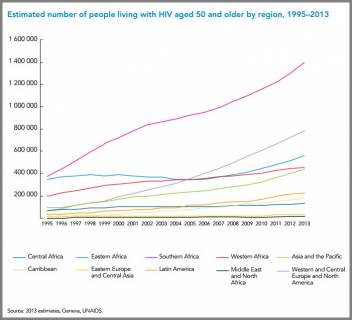UNAIDS has launched its annual global report, the “UNAIDS Gap Report”. For the first time there is a dedicated section on people aged 50 and over which explores what it means to be an older person living with HIV.
Having worked for many years on this issue, we at HelpAge are delighted to see UNAIDS highlighting this crucial and neglected aspect of the HIV epidemic.
The report highlights UNAIDS’s increased commitment to the issue of HIV and ageing over the last couple of years. At the end of 2013 it published “HIV and Aging” with new HIV statistics on the number of people aged 50 and over living with HIV.
The Gap Report is another step in increasing awareness of how HIV affects people in older age, and must lead to a more inclusive response to the epidemic.
New HIV statistics and ageing
The report presents data on people aged 50 and over living with HIV and highlights some of the key issues they face. Key statistics from the report include:
- 4.2 million people aged 50 and older are living with HIV today.
- More than 2.5 million people aged 50 and older live in sub-Saharan Africa, accounting for 60% of all people living with HIV over the age of 50.
- 13% of the global adult population living with HIV is aged 50 or older.
- Approximately 100,000 people aged 50 and over were newly infected with HIV in sub-Saharan Africa in 2013.
 The report also shows the continual increase in people aged 50 and over living with HIV over the last 18 years, clearly demonstrating the changing age structure of the HIV epidemic.
The report also shows the continual increase in people aged 50 and over living with HIV over the last 18 years, clearly demonstrating the changing age structure of the HIV epidemic.
UNAIDS highlights the main reasons older people are being left behind in the HIV response:
- low perception of HIV risk
- complications of managing HIV and other health issues
- access to services
- stigma and discrimination
The report highlights that older people remain sexually active but levels of condom use are low. This is consistent with our work in east and southern Africa and in our population based HIV surveys.
Managing HIV with other health conditions
An emerging challenge is the multiple health conditions experienced by people in older age with HIV and how they can be managed. Research in Uganda showed people aged 50 and over living with HIV had an average of five health conditions. This demonstrates the need to strengthen health systems so they can support ageing populations.
The question now is how the HIV community can address the neglect of people aged 50 and over. UNAIDS highlights the need for early HIV detection and treatment. We know that older people are less likely to test for HIV, and therefore may be diagnosed late, making treatment less effective.
But we also know that if older people are offered an HIV test in a way that is acceptable to them, they do want to know their status.
Our work in east and southern Africa over the last five years led to an increase in the percentage of people aged 50 and over who had been tested from 30% in 2008 to 80% in 2013.
Access to services fundamental for those living with HIV
The report also highlights the importance of older people having access to medical and psychological support and social protection to mitigate the economic impacts of living with HIV. Having worked on all these issues, we couldn’t agree more!
UNAIDS also makes a plea for improvements to data collection systems, recognising that age and sex disaggregated data for the 50 and over is rarely collected, analysed, reported or used. This is an issue HelpAge has worked on for many years. It is a huge step forward that UNAIDS is able to present these current HIV statistics.
Closing the gap
In the report, Michel Sidibe, UNAIDS Executive Director states the need to “close the gap” and meet the needs of those currently left behind.
Older people have been one such group, but this new data brings visibility to the millions aged 50 and over living with HIV.
It is all our responsibility to ensure they are no longer left behind in the response to HIV.
What next?
- The International AIDS Conference is underway in Melbourne, visit the AIDS 2014 website.
- Watch our animation on the discrimination faced by older women living with HIV.
